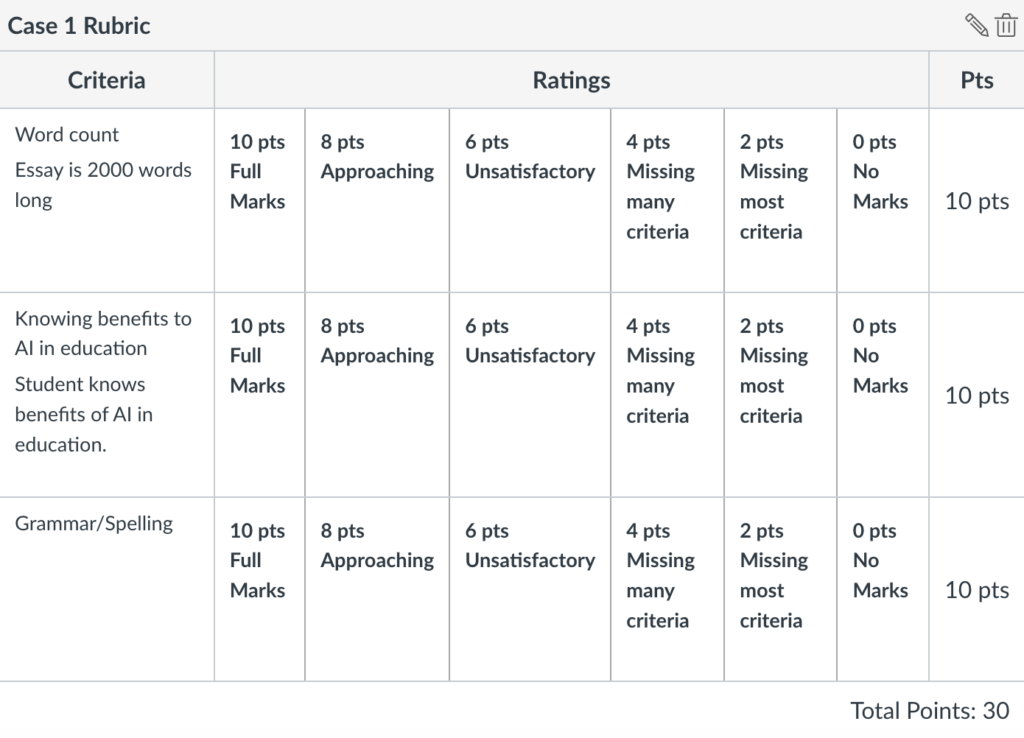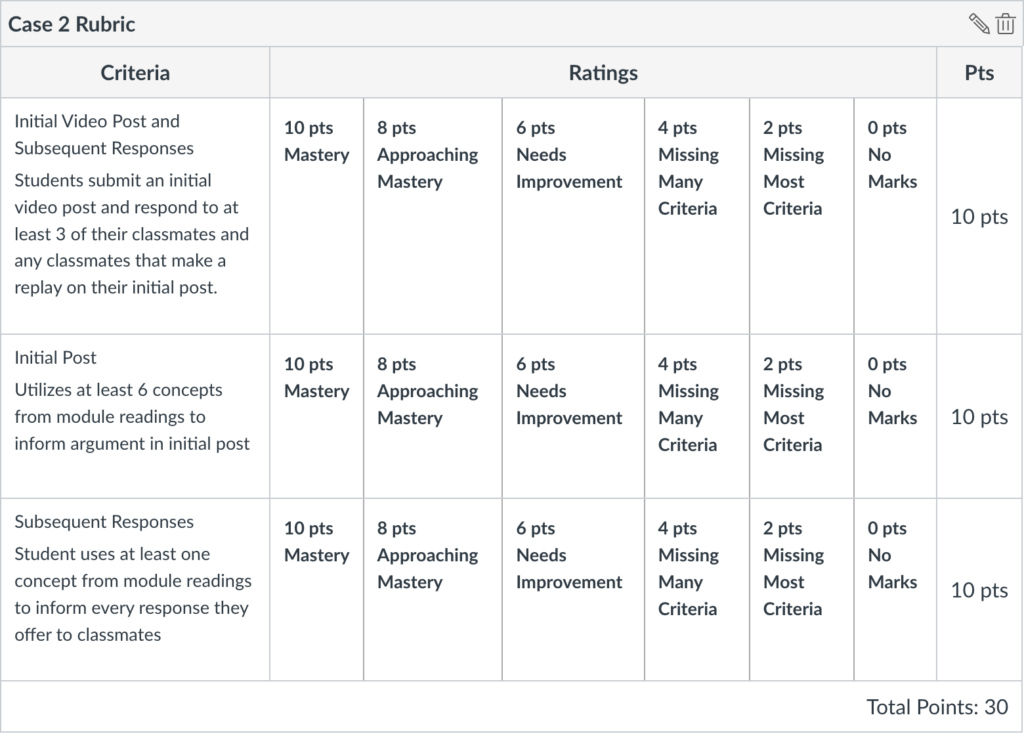Last updated on March 6, 2024
Imagine running a marathon without any signs to guide you or a visible finish line. You wouldn’t know where to go or if you’ve completed the race. This confusion mirrors what happens in a learning experience when course activities and assessments aren’t aligned with the desired outcomes.
In a well-organized marathon, the finish line represents the clear goal runners aim for, similar to how clear outcomes define what students should master in a course. Properly aligned rubrics can add tremendous value to your course, for both you and your students. Rubrics aligned with learning objectives more consistently measure student outcomes by creating a structure that guides them through activities. Furthermore, adding specific criteria to rubrics makes for an efficient grading process while fostering a fair learning environment.
Of course, you might be thinking that rubrics seem tedious, vague, or too specific. However, once they are created, they can reduce both the time burden and strain of being the sole judge of your students’ work as they can offer a more streamlined and objective grading process. What is more, they save time by making grading faster as well. From a student’s perspective, rubrics let them know how they are being measured by communicating clear criteria. In a word, aligning rubrics with learning objectives saves you time while creating a transparent, consistent metric for measuring success.
In this Spotlight, we will take an instructional design perspective on how to align a rubric with course outcomes, create clear rubric criteria, and critique two rubrics. If you would like to review how to build a rubric in Canvas before continuing in this Spotlight, refer to the CTLD tutorial on creating rubrics.
Contents
Best Practices
How should I align rubrics with outcomes?
- Rubrics can only be aligned with the outcomes of your course after clear objectives have been established. These will most often be in the form of Course Level Objectives (CLOs) and Module Level Objectives (MLOs), with MLOs helping students achieve the CLOs for the course. CLOs and MLOs should incorporate an action verb that describes what the students should be able to do when they achieve the objective. Action verbs that describe what students will be able to do when achieving an objective may include: explain, list, debate, analyze, or synthesize.
- Add clear, measurable criteria to the rubric. Rubrics are best used for assignments or activities that can be broken down into a sequence of steps or skills, and each of these should translate to a criterion in the rubric that can be observed. This mitigates grading issues introduced by subjective evaluation on the instructor’s part.
- Ensure the activity or assignment you use the rubric for is clearly connected to a CLO or MLO. For instance, if the CLO being measured is a debate, the activity or assignment should align with that, such as with a discussion.
- Align rubrics with outcomes for assignments you deem critical to demonstrate mastery of an objective. You can also use the same rubric for a series of assignments contributing to a CLO, such as a weekly discussion.
What should I avoid when aligning rubrics with outcomes?
- Avoid CLOs/MLOs that are not actionable. Every outcome at the module and course level should describe an action verb that describes what students will be able to do when they achieve it. Unmeasurable descriptions of what students will be able to do when they achieve an objective may include: know, understand, appreciate, or learn.
- Generally, avoid creating rubrics for assignments or quizzes that cannot be broken down into aggregate parts. This is to say, rubrics are best used for assignments that require multiple skills or steps to complete them and for this reason may not be well-suited for a quiz or multiple-choice test.
- Avoid disconnections between your objective, rubric, and assignment type. For instance, if the objective states students will be able to discuss a topic using specific academic language outlined in the rubric, the assignment should not be a quiz or essay. A discussion of some kind would be better suited for this objective.
What makes a good rubric?
Here are some basic, foundational features of a rubric aligned with an outcome:
- The rubric is built so that it minimizes subjective evaluation. The comment section in the Speedgrader menu can be used for more subjective evaluations. To review how to add comments to an assignment, review the CTLD Spotlight on Using SpeedGrader in Canvas.
- The rubric guides students toward clear, actionable objectives.
- The criteria for the rubric consist of multiple steps or skills that add up to meeting an objective.
- The activity for which the rubric was created is clearly connected to the objective.
- The criteria for the rubric are specific and easy to understand for both the instructor and students.
Let’s walk through it together
Cases:
Now, let’s look at two cases of aligning a rubric with an outcome. This will help to understand basic issues that may arise in creating your rubrics, as well as simple strategies to align them with your outcomes more effectively.
Case 1:
The rubric below is attached to an assignment and means to measure the Course Level Objective: Students will know the potential benefits of generative AI in education. The rubric is attached to an assignment for which students will submit an essay. The rubric has three criteria:
- Word count
- Knowing the potential benefits of generative AI in education
- Grammar/spelling

Critique:
The objective being measured does not use an action verb that allows us to measure it. We never measure if students “know” a concept unless they can show it in action, and the evaluation of what they know is left completely to the instructor’s subjective judgment. While the essay is broken down into aggregate parts, the word count and grammar/spelling requirements don’t connect much to the outcome, yet they are worth half the grade. The requirement for students to know the potential benefits of AI doesn’t specify which benefits, where they are found in the course, or how they should be added to the essay.
This rubric is not in clear alignment with the objective, the objective is not measurable, and the activity has no clear connection to the objective. As you create rubrics in your course, try to avoid the issues this rubric demonstrates.
Case 2:
The rubric below is attached to a GoReact assignment and means to measure the following objective: Students will debate the potential benefits of generative AI in education. The rubric is attached to an assignment for which students will submit initial videos, 3 video responses to their peers, and video responses to any students who reply to their initial post. The rubric has three criteria:
- Initial/subsequent video post
- Students use at least six concepts covered in their module readings to inform their initial post.
- Students use at least one concept covered in their module readings to inform any claim they make in their responses.

Critique:
Firstly, the objective uses an action verb — “debate” — and is measurable. The activity, a video discussion using GoReact, is clearly connected to the objective, which is to debate the benefits of generative AI in education. The rubric breaks this skill down into aggregate steps that are required to meet this objective and the criteria are measurable, which makes for a more objective evaluation of student work. The requirement for an initial post lets students know they must contribute their ideas to the debate and the requirements for the post clearly state they must use concepts from a specific module in their course. Lastly, for a debate to occur, students must use those same concepts to debate other initial posts and responses to their own.
The rubric clearly aligns with the objective, and the activity has a clear connection to it as well. As you develop your assignments and objectives, try to build alignment between rubrics and outcomes in the way this case models.